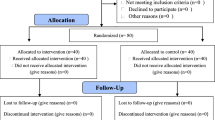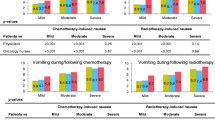Abstract
Objectives
The purpose of this present study was to evaluate Self-care Improvement through Oncology Nursing (SCION) program to reduce distressing anorexia, nausea, and emesis (ANE) in cancer patients undergoing chemotherapy.
Methods
Two hundred eight patients receiving chemotherapy with moderate to high emetogenic potential participated in a cluster randomized trial on 14 wards in two German university hospitals. Additionally to standard antiemetic treatment, patients from the intervention wards received the SCION program consisting of four modules: advisory consultation, optimizing emesis prophylaxis, nutrition counseling, and relaxation. Patients from the control group received standard antiemetic treatment and standard care. Primary outcome was the group difference in ANE intensity assessed by Common Terminology Criteria for adverse events (CTCAE).
Main results
The SCION program did not result in a significant difference in the incidence of ANE symptoms as compared to standard care: mean difference on CTCAE scale was 0.24 pts (95%CI, −1.17 to 1.66 pts; P = 0.733). No difference could be found regarding patients’ knowledge of side effects, self-care interventions, and agency. Health-related quality of life was significantly better for patients in the control group (mean difference 10.2 pts; 95%CI, 1.9 to 18.5; P = 0.017).
Conclusions
Contrary to our expectations, the groups did not differ in ANE intensity caused by the overall low acute or delayed symptom intensity. Symptom hierarchy in cancer patients alters and challenges nursing interventions targeting the patients’ self-care strategies.



Similar content being viewed by others
References
Aapro MS, Molassiotis A, Olver I (2005) Anticipatory nausea and vomiting. Support Care Cancer 13(2):117–121
Aaronson NK, Ahmedzai S, Bergman B et al (1993) The European Organization for Research and Treatment of Cancer QLQ-C30: a quality-of-life instrument for use in international clinical trials in oncology. J Natl Cancer Inst 85:365–376
Ashbury FD, Findlay H, Reynolds B, McKerracher K (1998) A Canadian survey of cancer patients’ experiences: are their needs being met? J Pain Symptom Manage 16(5):298–306
Baldwin C, Parsons T, Logan S (2007) Dietary advice for illness-related malnutrition in adults. Cochrane Database Syst Rev 1:CD002008
Ballatori E, Roila F (2003) Impact of nausea and vomiting on quality of life in cancer patients during chemotherapy. Health Qual Life Outcomes 1:1–11
Benor DE, Delbar V, Krulik T (1998) Measuring impact of nursing intervention on cancer patients’ ability to control symptoms. Cancer Nurs 21(5):320–334
Borjeson S, Hursti TJ, Tishelman C, Peterson C, Steineck G (2002) Treatment of nausea and emesis during cancer chemotherapy. Discrepancies between antiemetic effect and well-being. J Pain Symptom Manage 24(3):345–358
Devine EC, Westlake SK (1995) The effects of psychoeducational care provided to adults with cancer: meta-analysis of 116 studies. Oncol Nurs Forum 22(9):1369–1381
Evers G, De Maesschalck L, Brouns G, Isenberg M, Philipsen H (2002) Die ASA-A-Skala für die Selbstbeurteilung. In: Evers G (ed) Professionelle Selbstpflege: Einschätzen-Messen-Anwenden. Huber, Bern, pp 59–89
Feyer P, Kleeberg UR, Steingraber M, Gunther W, Behrens M (2008) Frequency of side effects in outpatient cancer care and their influence on patient satisfaction—a prospective survey using the PASQOC questionnaire. Support Care Cancer 16(6):567–575
Figueroa-Moseley C, Jean-Pierre P, Roscoe JA et al (2007) Behavioral interventions in treating anticipatory nausea and vomiting. J Natl Compr Canc Netw 5(1):44–50
Foubert J, Vaessen G (2005) Nausea the neglected symptom? Eur J Oncol Nurs 9(1):21–32
Griffin AM, Butow PN, Coates AS et al (1996) On the receiving end. V: patient perceptions of the side effects of cancer chemotherapy in 1993. Ann Oncol 7(2):189–195
Grunberg SM, Deuson RR, Mavros P et al (2004) Incidence of chemotherapy-induced nausea and emesis after modern antiemetics. Cancer 100(10):2261–2268
Hesketh PJ (2008) Chemotherapy-induced nausea and vomiting. N Engl J Med 358(23):2482–2494
Hesketh PJ (1999) Defining the emetogenicity of cancer chemotherapy regimens: relevance to clinical practice. Oncologist 4(3):191–196
Hofman M, Morrow G, Roscoe J et al (2004) Cancer patients’ expectations of experiencing treatment-related side effects. Cancer 101:851–857
Ihbe-Heffinger A, Ehlken B, Bernard R et al (2004) The impact of delayed chemotherapy-induced nausea and vomiting on patients, health resource utilization and costs in German cancer centers. Ann Oncol 15(3):526–536
Knobf MT (2007) Psychosocial responses in breast cancer survivors. Sem Oncol Nurs 23(1):71–83
Kris MG, Hesketh PJ, Somerfield MR et al (2006) American Society of Clinical Oncology Guideline for Antiemetics in Oncology: update 2006. J Clin Oncol 24(18):2932–2947
Lakusta CM, Atkinson MJ, Robinson JW, Nation J, Taenzer PA, Campo MG (2001) Quality of life in ovarian cancer patients receiving chemotherapy. Gynecol Oncol 81(3):490–495
McQuellon RP, Wells M, Hoffman S et al (1998) Reducing distress in cancer patients with an orientation program. Psychooncology 7(3):207–217
Milne AC, Potter J, Avenell A (2005) Protein and energy supplementation in elderly people at risk from malnutrition. Cochrane Database Syst Rev 2:CD003288
Murray D (1998) Design and analysis of group-randomized trials. Oxford University Press, New York
Osoba D, Zee B, Warr D, Latreille J, Kaizer L, Pater J (1997) Effect of postchemotherapy nausea and vomiting on health-related quality of life. The quality of life and symptom control committees of the National Cancer Institute of Canada clinical trials group. Support Care Cancer 5(4):307–313
Ravasco P, Monteiro-Grillo I, Vidal PM, Camilo ME (2005) Dietary counseling improves patient outcomes: a prospective, randomized, controlled trial in colorectal cancer patients undergoing radiotherapy. J Clin Oncol 23(7):1431–1438
RCN (2002) Principles for best practice in clinical audit. National Institute for Clinical Excellence, London
Roila F, Hesketh PJ, Herrstedt J (2006) Prevention of chemotherapy- and radiotherapy-induced emesis: results of the 2004 Perugia International Antiemetic Consensus Conference. Ann Oncol 17(1):20–28
Roscoe JA, Bushunow P, Morrow GR et al (2004) Patient expectation is a strong predictor of severe nausea after chemotherapy: a University of Rochester Community Clinical Oncology Program study of patients with breast carcinoma. Cancer 101(11):2701–2708
Rothwell PM (2005) Treating individuals 2. Subgroup analysis in randomised controlled trials: importance, indications, and interpretation. Lancet 365(9454):176–86
Tanghe A, Vandekerckhove L, Bras L et al (2002) Der Selbstpflege-Fragebogen für Beschwerden durch Chemotherapie. In: Evers G (ed) Professionelle Selbstpflege: Einschätzen-Messen-Anwenden. Hans Huber, Bern, pp 263–287
Tipton JM, McDaniel RW, Barbour L et al (2007) Putting evidence into practice: evidence-based interventions to prevent, manage, and treat chemotherapy-induced nausea and vomiting. Clin J Oncol Nurs; 11(1):69–78
Williams SA, Schreier AM (2004) The effect of education in managing side effects in women receiving chemotherapy for treatment of breast cancer. Oncol Nurs Forum 31(1):E16–E23
Acknowledgements
Funding for this research was provided by the German Federal Ministry of Education and Research (BMBF)—Grant No. 01GT0301.
Author information
Authors and Affiliations
Corresponding author
Rights and permissions
About this article
Cite this article
Jahn, P., Renz, P., Stukenkemper, J. et al. Reduction of chemotherapy-induced anorexia, nausea, and emesis through a structured nursing intervention: a cluster-randomized multicenter trial. Support Care Cancer 17, 1543–1552 (2009). https://doi.org/10.1007/s00520-009-0698-z
Received:
Accepted:
Published:
Issue Date:
DOI: https://doi.org/10.1007/s00520-009-0698-z




